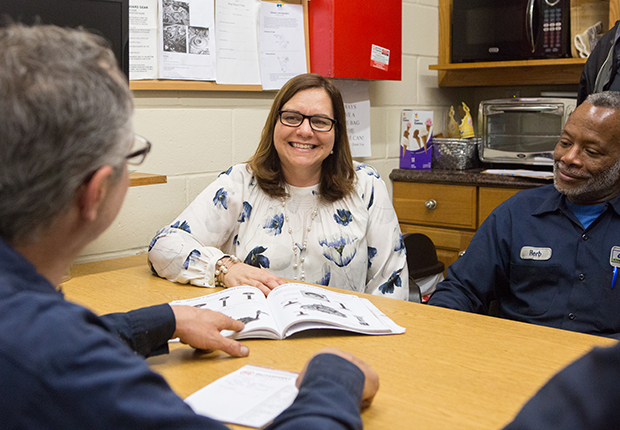AARP Hearing Center

By Natalie Missakian
When Maryann Croce hires an employee at her automotive repair shop in Norwalk, she assigns a senior team member to take the newcomer under his wing.
The pairing does more than bring the often younger worker up to speed on company practices. It’s a step toward nurturing the next generation of workers in a trade that, like many, is struggling to replenish a workforce nearing retirement.
Encouraging relationships, Croce said, helps bridge the cultural differences that can separate millennials and boomers in the workplace. “It helps to have the different generations working together, because they see the value that each can bring,” she said.
She’s noticed that younger workers are often happy to teach the latest technology, while veterans can pass on decades of institutional knowledge that would otherwise be lost when they leave.
“Really, both people are learning, and it’s a give-and-take,” said Croce, 57, of Trumbull.
The co-owner, with her husband, of Croce’s Transmission Specialists since 1999, Croce shared her approach during a series of business roundtables last year aimed at helping employers prepare for an aging workforce. The forums were sponsored by AARP Connecticut and the Madison-based consulting firm Borrow My Glasses.
The discussions were part of AARP Connecticut’s Disrupt Aging program, inspired by AARP CEO Jo Ann Jenkins’ book of the same name, which encourages people to redefine what it means to get older, especially as they live and work longer.
The first phase of the program brought conversations about ageism and stereotypes to community groups. The second phase focuses on business and industry, and the third will take place in classrooms, so students and older people can learn from one another.
A resource for employers
“Every single business will be impacted by the aging trend, and we want to help them deal with the impact,” said Lauren Lewis, cofounder and chief operating officer of Borrow My Glasses, which provides consulting and training on aging issues.
Erica Michalowski, AARP Connecticut’s community outreach and education director, noted that residents 65-plus make up 16 percent of the state’s population and that's expected to grow to 19 percent by 2022.
That will mean changes in the workforce, such as people staying on past traditional retirement age, more caregivers working and multiple generations working together. Companies must also transform how they do business to meet the needs of an older market, Michalowski said.
Lewis added: “We’re going to need innovation across every industry, new ways to understand work and retirement patterns, and new ways to support caregivers in the workforce.”
During an event at Central Connecticut State University last December, most business participants said their organizations were dealing with the aging trend, Michalowski said, but few had strategies in place.
Borrow My Glasses and AARP Connecticut produced a video urging businesses to devote 5 percent of their time to thinking about the issue.
“The aging trend is huge, but you can make it manageable,” Lewis tells employers.
AARP is prepared to share the presentation with companies around the state. To schedule a one-hour conversation at your company, contact Michalowski at emichalowski@aarp.org.
Natalie Missakian is a writer living in Cheshire, Conn.































































